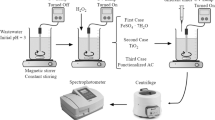Abstract
The discharges of the wastewater from the textile industry generate a substantial quantity of effluents which can cause various environmental problems, if disposed of without any prior treatment. Therefore, the treatment of these textile effluents is necessary. The present study aims to investigate the removal efficiency of colors from wastewater containing mixed primary direct dyes and real textile industry wastewater using PDS (Peroxydisulfate)/Fe(II)/UV process. A simulated mixture, based on an industrial recipe and containing Reactive Yellow 17 (RY17), Reactive Red 120 (RR120), and Reactive Blue 19 (RB19), was investigated. The obtained results showed that the mineralization rate is around 96.1% for RY17, 99.2% for RR120, 100% for RB19 and 80% for their mixed during 2 h of the treatment. The degradation of real textile wastewater was about 66% under similar conditions. The evaluations showed that ~ 93.82 MAD/m3 (~ 8.64 EURO/m3) is needed to supply the operating cost. As a vital industrial criterion, it was estimated that the conditions of initial pH of 3, [PDS] = 1 mM and T = 25 °C the highest cost effective case of the process for degrading the mixed dyes. Phytotoxicity studies revealed that the degradation products of mixed dyes and textile effluent were scarcely toxic in nature, thereby increasing the applicability of PDS/Fe(II)/UV for the treatment of textile wastewater. This will open a perspective for the reuse of treated water in crop irrigation. Based on the results of the advanced oxidation technologies experiments, it was found that PDS/Fe(II)/UV is the best treatment method for real textile wastewater.




Similar content being viewed by others
Abbreviations
- AOT:
-
Advanced oxidation technology
- CC:
-
Chemical cost
- DE:
-
Degradation efficiency
- RB19:
-
Reactive blue 19
- EC:
-
Electricity cost
- UV:
-
Ultra violet
- K :
-
Rate constant
- RR120:
-
Reactive Red 120
- PDS:
-
Peroxydisulfate
- RY17:
-
Reactive Yellow 17
- COD:
-
Chemical oxygen demand
- MD:
-
Mixed dyes
- Dt:
-
Reaction time
- MAD:
-
Moroccan Dirham
- OC:
-
Operating cost
- TW:
-
Textile wastewater
- BOD:
-
Biochemical oxygen demand
- EEC:
-
Electrical energy consumption
References
Sahu O, Singh N (2019) Significance of bioadsorption process on textile industry wastewater (Chap. 13). In: The impact and prospects of green chemistry for textile technology. Elsevier, pp 367–416. https://doi.org/10.1016/B978-0-08-102491-1.00013-7
Sharma A, Syed Z, Brighu U, Gupta AB, Ram C (2019) J Clean Prod 220:23–32
Laqbaqbia M, García-Payoa MC, Khayeta M, El Kharrazc J, Chaouchb M (2019) Sep Purif Technol 209:815–825
Lin CY, Chiang CC, Nguyen TML, Lay CH (2017) Int J Hydro Ener 42:29159–29165
Khatri A, Peerzada MH, Mohsin M, White M (2015) J Clean Prod 87:50–57
Takeda K, Fujisawa K, Nojima H, Kato R, Ueki R, Sakugawa H (2017) J Photochem Photobiol A Chem 340:8–14
Gao Y, Zhang Z, Li S, Liu L, Yao L, Li Y, Zhang H (2016) Appl. Catal B Environ 185:22–30
Zhang R, Wang X, Zhou L, Crump D (2019) Chem Eng J 361:960–967
Bougdour N, Tiskatine R, Bakas I, Assabbane A (2019) Mater Today Proc. https://doi.org/10.1016/j.matpr.2019.08.083
Matzek LW, Carter KE (2016) Chemosphere 151:178–188
Oh WD, Dong Z, Lim TT (2016) Appl Catal B Environ 194:169–201
Ji Y, Dong C, Kong D, Lu J, Zhou Q (2015) Chem Eng J 263:45–54
Wei Z, Villamena FA, Weavers LK (2017) Environ Sci Technol 51:3410–3417
Lin C, Lee L, Hsu L (2013) J Photochem Photobiol A Chem 252:1–7
Ahmed MM, Barbati S, Doumenq P, Chiron S (2012) Chem Eng J 197:440–447
Dong Z, Jiang C, Yang J, Zhang X, Dai W, Cai P (2019) J Hazar Mater 373:519–526
Ji Y, Ferronato C, Salvador A, Yang X, Chovelon JM (2014) Sci Total Environ 472:800–808
Xu XR, Li XZ (2010) Sep purif Technol 72:105–111
Bougdour N, Sennaoui A, Bakas I, Assabbane A (2018) Sci Technol Mater 30(3):157–165
Dubber D, Gray NF (2010) J Environ Sci Health, Part A 45(12):1595–1600
Bayramoglu M, Kobya M, Can OT, Sozbir M (2004) Sep Purif Technol 37:117–125
Zarei AR, Rezaeivahidian H, Soleymani AR (2015) Proces Safe Environ Prot 98:109–115
Behnajady MA, Modirshahla N (2006) Ind Eng Chem Res 45:553. https://doi.org/10.1016/j.psep.2015.07.006
Behnajady MA, Vahid B, Modirshahla N, Shokri M (2009) Desali 249:99–103
Zou J, Peng X, Li M, Xiong Y, Wang B, Dong F, Wang B (2017) Chemos 171:332–338
Saratale RG, Sivapathan S, Saratale GD, Banu JR, Kim DS (2019) Ecotoxicol Environ Saf 167:385–395. https://doi.org/10.1016/j.ecoenv.2018.10.042
Author information
Authors and Affiliations
Corresponding author
Rights and permissions
About this article
Cite this article
Bougdour, N., Tiskatine, R., Bakas, I. et al. Textile Wastewater Treatment by Peroxydisulfate/Fe(II)/UV: Operating Cost Evaluation and Phytotoxicity Studies. Chemistry Africa 3, 153–160 (2020). https://doi.org/10.1007/s42250-019-00094-7
Received:
Accepted:
Published:
Issue Date:
DOI: https://doi.org/10.1007/s42250-019-00094-7




